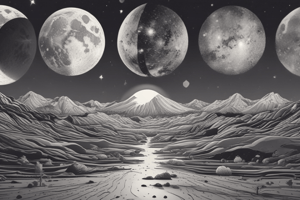Podcast
Questions and Answers
The moon produces its own light that we can see from Earth.
The moon produces its own light that we can see from Earth.
False (B)
The new moon phase occurs when the moon is fully visible in the night sky.
The new moon phase occurs when the moon is fully visible in the night sky.
False (B)
The moon appears as a full circle during the waxing crescent phase.
The moon appears as a full circle during the waxing crescent phase.
False (B)
The first quarter phase occurs when the moon is fully lit on its surface.
The first quarter phase occurs when the moon is fully lit on its surface.
The full moon phase occurs when the moon is between the earth and the sun.
The full moon phase occurs when the moon is between the earth and the sun.
The waning stage begins before the full moon phase.
The waning stage begins before the full moon phase.
The lunar cycle takes approximately 30 days to complete.
The lunar cycle takes approximately 30 days to complete.
The term 'waxing' describes the moon's apparent shrinkage.
The term 'waxing' describes the moon's apparent shrinkage.
Flashcards are hidden until you start studying
Study Notes
The Moon's Phases
- The moon doesn't emit light itself; the moonlight we see is actually the sun's light reflected off the lunar surface.
- The moon's transformation from new moon to full moon and back again is due to the lunar cycle or phases of the moon.
New Moon
- The new moon phase occurs when the moon is exactly in the middle of the earth and the sun, making it nearly invisible in the night sky.
- The side of the moon facing the earth does not receive sunlight during this phase.
Waxing Phase
- The waxing phase begins after the new moon, when the moon moves ahead in its orbit and some sunlight starts to fall on its surface.
- The moon appears in a crescent shape during the waxing crescent phase.
- As the moon continues its orbital journey, the sun's reflection increases on its surface, and in about a week, we can see its half-lit portion, known as the first quarter.
Waxing Gibbous
- After the first quarter, the moon is more than half full and still increasing its illuminated surface, entering the waxing gibbous phase.
Full Moon
- In about two weeks after the new moon, the moon reaches behind the earth with respect to the sun, and the full side of the moon facing the earth receives sunlight, making it fully visible.
Waning Stage
- The waning stage begins after the full moon, where the moon starts its return journey to the new moon phase.
- The waning gibbous phase occurs when the light begins to decrease on the moon's surface.
- The last quarter phase occurs when the moon is once again half-illuminated, but the lit area visible is on the decline.
- The waning crescent phase occurs when the moon shrinks back to a crescent that's less than half full.
Lunar Cycle
- The moon completes its journey in about 29.5 days and comes back between the earth and sun to its new moon phase, marking the completion of the lunar cycle.
- The terms "waxing" and "waning" describe the moon's apparent growth and shrinkage, respectively.
- The word "gibbous" comes from the Latin for "hump" and has been used for centuries to describe rounded or convex shapes.
The Moon's Phases
- Moonlight is actually the sun's light reflected off the lunar surface, as the moon doesn't emit light itself.
New Moon
- Occurs when the moon is exactly between the earth and sun, making it nearly invisible in the night sky.
- The side of the moon facing the earth does not receive sunlight during this phase.
Waxing Phase
- Begins after the new moon, when the moon moves ahead in its orbit and some sunlight starts to fall on its surface.
- The moon appears in a crescent shape during the waxing crescent phase.
- The first quarter occurs when the moon's half-lit portion is visible, approximately a week after the new moon.
Waxing Gibbous
- The moon is more than half full and still increasing its illuminated surface.
- The sun's reflection increases on the moon's surface during this phase.
Full Moon
- Occurs when the moon reaches behind the earth with respect to the sun, and the full side of the moon facing the earth receives sunlight.
- The full moon is fully visible in the night sky.
Waning Stage
- Begins after the full moon, where the moon starts its return journey to the new moon phase.
- The waning gibbous phase occurs when the light begins to decrease on the moon's surface.
- The last quarter phase occurs when the moon is once again half-illuminated, but the lit area visible is on the decline.
- The waning crescent phase occurs when the moon shrinks back to a crescent that's less than half full.
Lunar Cycle
- The moon completes its journey in about 29.5 days.
- The terms "waxing" and "waning" describe the moon's apparent growth and shrinkage, respectively.
- The word "gibbous" comes from the Latin for "hump" and has been used for centuries to describe rounded or convex shapes.
Studying That Suits You
Use AI to generate personalized quizzes and flashcards to suit your learning preferences.




